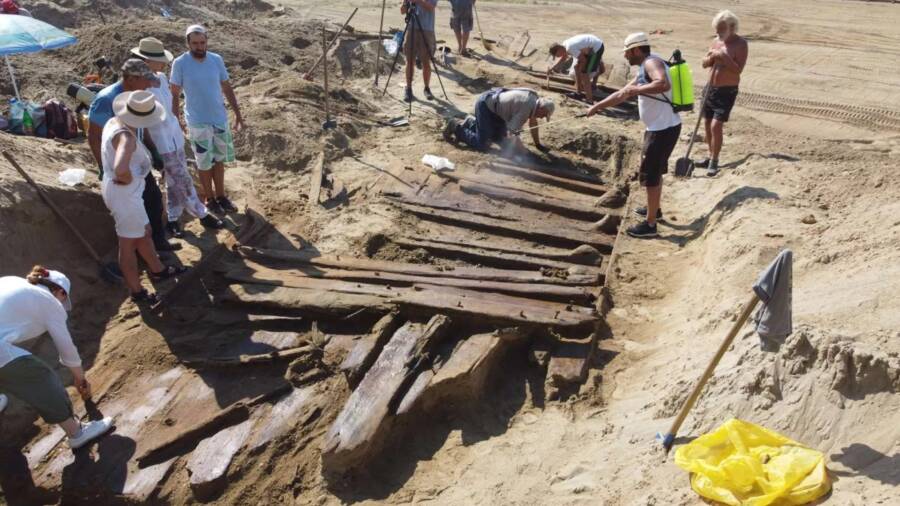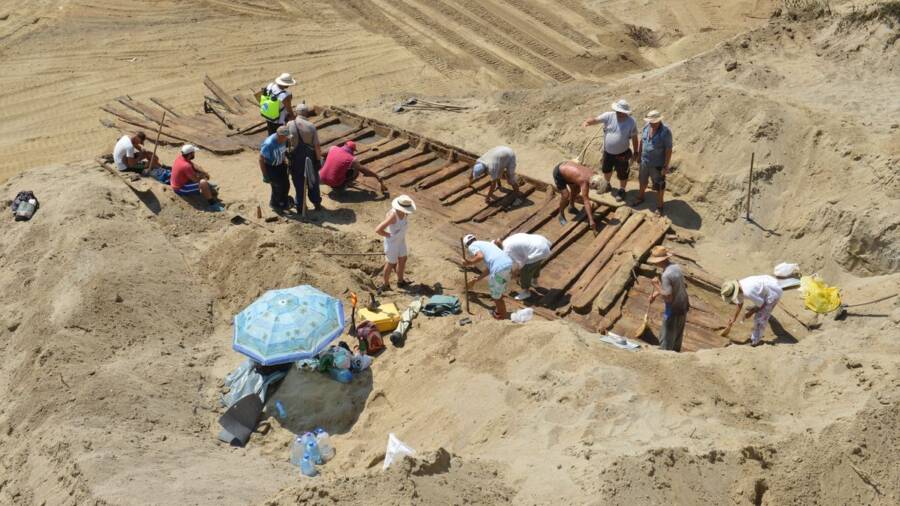The ship likely dates back to the third or fourth century C.E. and may have served the nearby Roman city of Viminacium.

Institute of Archaeology, BelgradeArchaeologists from the Institute of Archaeology, Belgrade working to keep the Roman ship remains damp while excavating them.
Coal miners working in Serbia recently uncovered the remains of a large wooden boat likely used by the ancient Romans to supply a nearby frontier city.
This marks the second such discovery in the area since 2020 when Serbian miners discovered the remains of a 1,300-year-old Roman-era warship at the Kostolac-area surface mine.
The newly discovered vessel has yet to be officially dated, but archaeologists estimate that it originated sometime around the third or fourth century C.E., suggesting that it was likely used to carry supplies along small rivers near the Roman city of Viminacium, about a mile away.

“We may assume that this ship is Roman, but we are unsure of its exact age,” lead archaeologist Miomir Korac told Reuters.
The ship was unearthed in late July at the Drmno surface mine near Kostolac, buried in a layer of silt roughly 25 feet below the surface. Coal miners came across it as they cut away the site’s topsoil with a mechanical digger, the method by which they would typically reach the coal mine seam.
They immediately contacted archaeologists from the nearby Viminacium archaeological park.
Archaeologists quickly realized something remarkably unique about the ship: it was still wet. Typically, organic materials, such as wood, would rot over such a long period of time.

Institute of Archaeology, BelgradeThe wreckage was likely kept so well-preserved by the moisture trapped within the wood and sand burying it.
However, as a spokesperson explained to the Serbian website Sve o arheologiji, “The wooden planks and beams were still wet, as was the sand above the ship. That’s how the ship was preserved so well, despite the past centuries.”
The spokesperson said that archaeologists had to work quickly to unearth the vessel, as the sun posed “a great danger” as it could dry out the ship too quickly, causing it to become damaged. To ensure the ship remained properly preserved, archaeologists frequently sprayed it with water throughout the excavation and kept it under a large tarpaulin to prevent decay in the heat.
It took two intensive days, but archaeologists were able to excavate the remains in full successfully. They were left with remains of a ship roughly 42 feet long and 11 feet wide, though part of the bow was damaged during the excavation. With it still intact, researchers estimated that the ship had likely been more than 60 feet in length at the time of its construction.
“Probably, the barge was towed from the shore or propelled by oars,” a spokesperson for the Archaeological Institute said, “and in suitable situations, the ship could also use the wind to move, with the use of an auxiliary sail.”

Institute of Archaeology, BelgradeThe Roman ship is the second discovery of its kind in the past three years.
Archaeologists also believe that the two ships and three canoes uncovered so far in the area were either abandoned or intentionally sank at the now dried-up river banks over 1,000 years ago.
In either case, these discoveries show just a fraction of the wealth of possibilities the Viminacium site offers. Despite excavations in the region beginning in 1882, researchers estimate they have only scoured roughly five percent of the site. The total size of the site measures over 1,000 acres, making it larger than New York’s Central Park, but it is especially unusual in that no new cities have been built on top of it.
In its heyday, Viminacium was a vital trading hub and regional center for the frontier of the Roman Empire. Archaeologists have estimated that its population was likely around 45,000 people, which would have made it one of the largest settlements in the Balkans at the time. It contained many features, including a hippodrome, fortifications, a palace, temples, amphitheater, aqueducts, baths, and workshops.
Unfortunately, both the city and the fort nearby were destroyed by the Huns in the fifth century C.E. as they toppled significant portions of the Roman Empire in Europe. And though it was rebuilt in the early sixth century by the Byzantine emperor Justinian the Great, it was once again destroyed in 582 C.E. by the invading Avars.
Still, the site has proven to be a treasure trove of archaeological discoveries. In addition to the various vessels found at the site, archaeologists have also discovered golden tiles, jade sculptures, mosaics and frescoes, weapons, and the remains of three mammoths.
After reading about the recent discovery of this Roman ship, read about the ancient Roman “service station” uncovered in England during construction of a soccer field. Then, see the ancient Roman relic unearthed in England that shows British prisoners were executed by lions.





